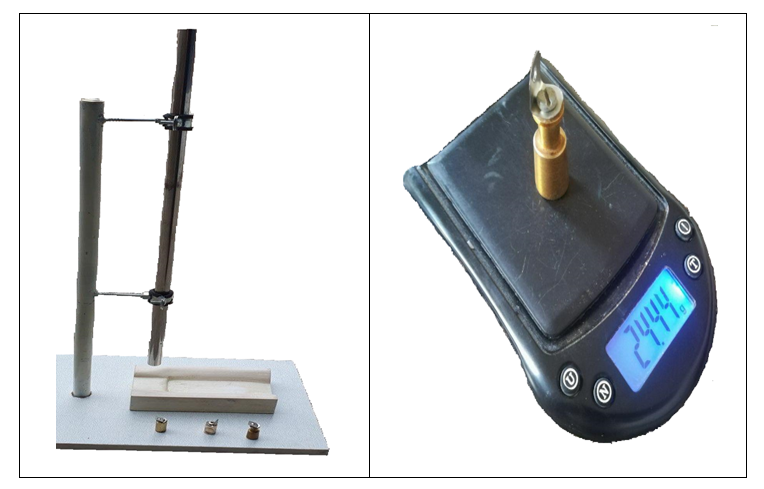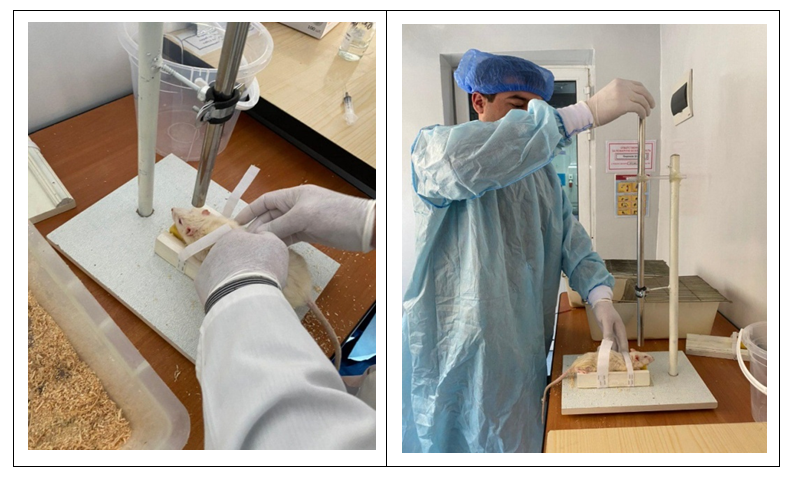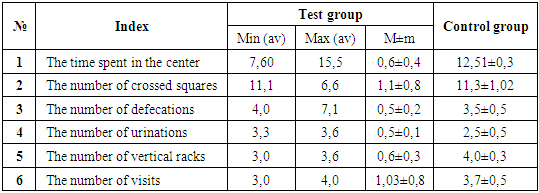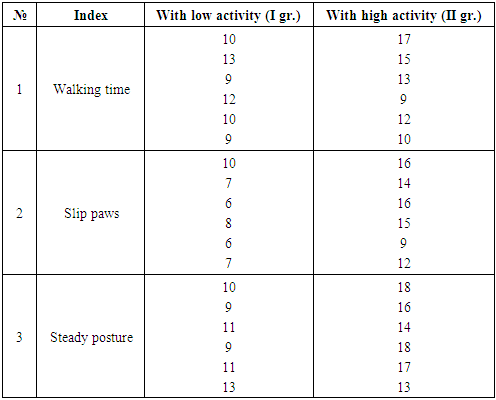-
Paper Information
- Next Paper
- Paper Submission
-
Journal Information
- About This Journal
- Editorial Board
- Current Issue
- Archive
- Author Guidelines
- Contact Us
American Journal of Medicine and Medical Sciences
p-ISSN: 2165-901X e-ISSN: 2165-9036
2020; 10(10): 803-808
doi:10.5923/j.ajmms.20201010.16
Received: Sep. 2, 2020; Accepted: Sep. 20, 2020; Published: Oct. 26, 2020

Study of Behavioral and Morphological Disorders in Animals with Modeled Pathology of Mild Traumatic Brain Injury
Khaydarov Furqat Ganievich, Khasanova Dilnoza Ahrorova
Anatomy, Clinical Anatomy (OSTA) Department, Bukhara State Medical Institute, Bukhara, Uzbekistan
Correspondence to: Khaydarov Furqat Ganievich, Anatomy, Clinical Anatomy (OSTA) Department, Bukhara State Medical Institute, Bukhara, Uzbekistan.
| Email: |  |
Copyright © 2020 The Author(s). Published by Scientific & Academic Publishing.
This work is licensed under the Creative Commons Attribution International License (CC BY).
http://creativecommons.org/licenses/by/4.0/

Changes in the brain tissues of animals that have suffered a mild traumatic brain injury correlate with data on neurological deficits and behavioral status of laboratory animals. With a mild traumatic brain injury in experimental animals, circulatory disorders occur in the area of damage to the cerebral cortex, which is expressed in edema of the walls of microvessels, a decrease in their lumen, and changes in the density of the vascular bed. When correcting a mild traumatic brain injury, it is necessary to evaluate the neuropsychiatric disorders by testing, to study the typological features and motor activity of the body.
Keywords: Experimental design turbine, Traumatic brain injury, Morphological changes, Neuropsychiatric disorders
Cite this paper: Khaydarov Furqat Ganievich, Khasanova Dilnoza Ahrorova, Study of Behavioral and Morphological Disorders in Animals with Modeled Pathology of Mild Traumatic Brain Injury, American Journal of Medicine and Medical Sciences, Vol. 10 No. 10, 2020, pp. 803-808. doi: 10.5923/j.ajmms.20201010.16.
Article Outline
1. Introduction
- One of the most common brain injuries of medico-social significance is craniocerebral injuries. As the analytical statistics show, Traumatic brain injury (TBI) is a serious problem throughout the world. The prevalence of TBI in the world varies significantly, ranging from 95 to 783 per 100 thousand people per year, and the mortality rate of the population is from 9.5 to 66 per 100 thousand people per year.The prevalence of TBI in our republic was 692 cases per 100 thousand population, and mortality in different regions of the country varies greatly, from 18.5 to 49 per 100 thousand population [1]. The causes of head injuries are very diverse, but the main mechanism of formation is the impact of an external force factor. Thus, its pathogenesis is characterized by interrelated processes of biochemical, morphological, and immunological disorders [2,3,4,5,6,7].To date, the attention of scientists is focused on mild craniocerebral trauma, which is due to the complexity of the diagnosis and the scarcity of objective signs of trauma, which could allow differentiation without craniotomy. In the complex of disorders of the central nervous system with mechanical damage, the influence of pathological disorders on the coordination system, behavioral nature, cognitive functions of the body, intracranial pressure, metabolism, etc. is of particular importance [8,9,10,11].Considering the versatility of disorders in mild traumatic brain injuries, the choice of treatment methods depends primarily on the severity of the injury, the location of the damage in the brain, the age and condition of the victim. So, different experts recommend and use different methods of treatment that contribute to the restoration of the processes of vital organs [12]. According to the latest scientific research to solve the problems associated with the choice of effective treatment methods is the use of experimental models that contribute to a detailed study of damage, as well as the use of corrective drugs that are not always safe for the human body.In order to further improve treatment methods and develop new ways of correction for mild traumatic brain injury, which is not accompanied by long-term and deep injuries in the brain, it is necessary to develop an experimental model and study the main disorders that allow objectively determining and differentiating the degree of injury.
2. Materials and Research Methods
- To achieve this goal, experimental studies were conducted on 90 white mongrel rats, males weighing 210 ± 4.8 g, which were kept instandard conditions of the vivarium of the Central Scientific Research Laboratory of Tashkent Pharmaceutical Institute with the provision of a diet in accordance with the daily nutritional standard for animals. Before creating an experimental model of mild traumatic brain injury for the study and comparative analysis of disorders among active and passive animals, the individuals were divided into 2 groups according to the typological status of higher nervous activity using the open field test. Thus, groups of animals with low and high activity were formed.In the study of neuropsychiatric disorders to identify asymmetric disorders of the brain and substantiate differentiated groups with different emotional and motor activity, the "Cylinder" test was carried out. According to the conditions of the test, the experimental animals were placed in an installation representing a plexiglass cylinder with a height of 30 cm and a diameter of 20 cm with a transparent bottom. The animals, being in an unfamiliar environment, began to exhibit orientation-exploratory behavior, expressed in active movement of the forelimbs on the walls of the cylinder. When climbing on hind legs, animals used one or both forelimbs (normally both legs are used). The results obtained were assessed by the number and quality of movements of the forelimbs with support on the cylinder walls. In addition, in order to determine the coordination of movement after the reproduction of traumatic brain injury on experimental animals on the second and seventh days, the test "Walk on a raised beam" was carried out. This technique was used to assess the state of equilibrium in animals with neurological disorders provoked by an external mechanical shock. So, to study the dynamics of performance indicators, which is one of the most significant clinical signs of the state of the central nervous system, a system was used, which is a raised crossbar of various configurations and thicknesses and a closed safe platform.According to the method, the experimental animals pass over the crossbar and reach its end, which is a safe area. During the method, the time of passage, slipping of the paws and falling is recorded. The results were evaluated by the time (sec) spent on 3 exponential movements.The complex of our studies included the study of morphological disorders after the simulation of mild traumatic brain injury in animals. The studies began with euthanasia, chloral hydrate 350 mg / kg was used for anesthesia by puncture of the left ventricle until complete exsanguination. In experimental animals, a biomaterial (brain) was isolated, which was fixed in a 10% formalin solution. For the study, a section of the cerebral cortex in the area of injury was excised. Prepared sections with a thickness of 4-6 micrometers were stained with hematoxylin and eosin. For microscopy and photographing, optical systems were used, consisting of a microscope and an eyepiece camera. On macro-preparations stained with hematoxylin and eosin, the state of capillaries, their blood supply, the state of the meninges, and cellular elements of the brain were studied.
3. Results
- Higher nervous activity, which ensures the continuous operation of all parts of the nervous system, has its own characteristics that characterize the actions of the body under various situations and conditions in the external environment. The behavior of an organism can change dynamically over time, which determines its individual abilities and helps prevent negative consequences as a result of its inadequate actions. The defined typological features of the organism represent a complex process of integration of cortical-subcortical relationships of higher nervous activity [13]. Thus, the features of the higher nervous activity of experimental animals were studied, on the basis of which the main indicators were identified for further breakdown into groups.To carry out an objective quantitative assessment of the functional state of the central nervous system and assess the effect of mechanical damage on the emotional and mental state, determine the activity and nature of behavior, animals were differentiated into experimental groups with low and high activity using the proven and widespread open field test.This test made it possible to assess the motor activity, to establish qualitative and quantitative indicators of the behavior of experimental animals under certain conditions. The main indicators for differentiation into groups were the following: the latent period of time spent in the center, the number of crossed squares, the number of defecations, the number of urination, the number of vertical racks, the number of washings. For visual convenience in identifying groups of different activities, animals were marked with different colors (yellow - active, green - low activity).The test was carried out using a large rectangular chamber (1.50x1.50 m) with walls 0.30 m high, lined with squares. The sides of the central square were 0.30 m, the peripheral squares were 0.15 m. At the intersection of the squares, there were holes 0.02 m in diameter. Lighting was provided by a 150 W shadowless lamp located at a height of 1.00 m above the center of the field. The animals were placed in the center of the field and their activity was recorded every second for 5 minutes. The time spent by the rat in the central square (the duration of the latent period), the time of immobility were recorded, the number of crossed central and peripheral squares (horizontal), the number of racks - lifting on the hind legs (vertical motor activity), the number of washes, the number of defecations and urinations were counted.According to the experimental studies carried out before the impact of the injury, the following results were obtained: the time spent in the center, measured in seconds, averaged 2.50-2.57 ± 0.6 s, the number of crossed squares - 10.2-12.6 ± 1, 1 pc., The number of defecations - 1.4-1.7 ± 0.5 pcs., The number of urinations - 0.3-0.5 ± 0.5 pcs., The number of vertical racks 4.0-6.5 ± 0, 6, the number of washes 3.8-5.2 ± 1.03 pcs (Tab. 1).
|
 | Figure 1. Experimental Structural Turbine and Weight for Modeling Mild TBI |
 | Figure 2. Stages of creating an experimental model of mild TBI |
|
4. Discussion and Conclusions
- To study behavioral and morphological disorders in mild traumatic brain injury, the experimental animal model is recommended to be reproduced by the “TBI as a result of a drop in weight” (free fall) method, which is the simplest and most effective modeling method. In order to further improve the methods of treatment and master new ways of correction in mild traumatic brain injury, it is necessary first of all to assess psychoemotional disorders, including motor activity, which is determined using the informative open field test. The morphological studies carried out refute the still existing opinion about the absence of morphological changes in mild TBI. Studies have shown that changes in the brain tissues of animals with mild TBI correlate with the data of neurological deficits and behavioral status of laboratory animals. With mild traumatic brain injury, experimental animals develop circulatory disorders in the area of damage to the cerebral cortex, which is expressed in edema of the walls of microvessels, a decrease in their lumen, and a change in the density of the vascular bed. Consequently, when correcting disorders of the brain, in particular with mild TBI, it is necessary to assess by testing neuropsychiatric disorders, to study typological features, motor activity of the body.
 Abstract
Abstract Reference
Reference Full-Text PDF
Full-Text PDF Full-text HTML
Full-text HTML
